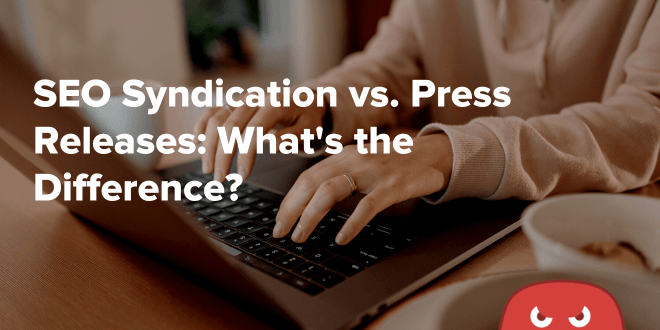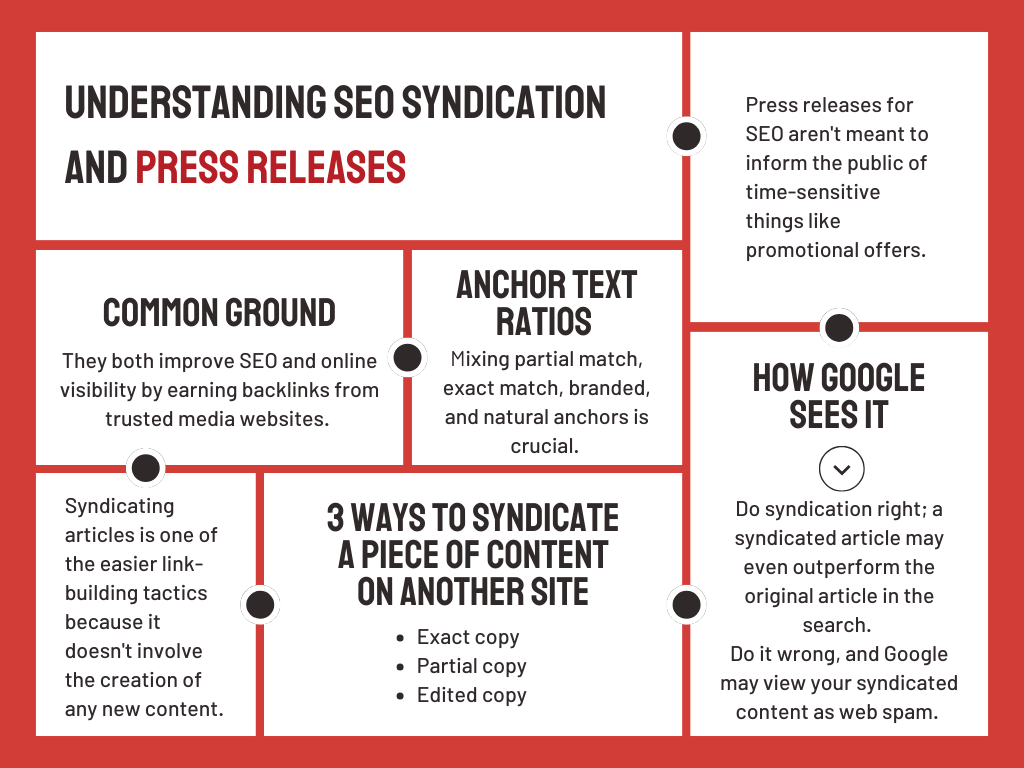Quick Links
At The HOTH, we offer many services for improving our client’s SEO through boosting online visibility.
Content creation, guest posting, and link insertions are a few examples of how we improve SERP (search engine results pages) rankings for our clients.
Yet, quite a bit of confusion surrounds two of our SEO offerings: article syndication and press releases.
While some may think the two are interchangeable, many noticeable differences exist between press releases and syndicated blogs.
The common ground is that they both improve SEO and online visibility by earning backlinks from trusted media websites.
However, the similarities end here, as they’re two completely separate link-building tactics.
Read on to learn more about the difference between syndication and press releases and how they will improve your website’s search engine rankings when done correctly.
Understanding Press Releases for SEO
Traditionally, a press release is an official statement by a business’s PR department to inform the public about a new development – such as new hires, mergers, product launches, and other noteworthy events.
Press releases for SEO are a tad different.
How so?
It’s because the primary goal of an SEO press release is to acquire backlinks and boost your online visibility.
That’s not to say that SEO press releases aren’t informative or that they don’t contain important new information about your business.
It just means that press releases for SEO aren’t meant to inform the public of time-sensitive things like promotional offers.
However, your press release must still be newsworthy to appear on news websites.
For our HOTH clients, we can create new SEO-friendly content for a new press release or help distribute existing press releases.
From there, our fulfillment team selects a group of relevant, authoritative news sites in our network to target for distribution.
Once the press releases go live, our clients gain increased brand visibility.
Thanks to our 300+ distribution channels, we can consistently boost brand awareness and online visibility for clients from virtually every niche.
Press releases for gray niches
A common question is whether we can provide our press release services for gray niches.
What are those?
A ‘gray’ niche is a business or activity that, while technically legal, features strict regulations.
An example would be a casino.
While gambling is legal in 48 states (the exceptions being Utah and Hawaii), federal and state laws determine when and where it can happen and the types of gambling that are allowed.
The good news is that we can provide our press release services to all gray niches except illicit drugs.
However, you’ll likely receive fewer links than you would for a traditional niche, but we can still deliver at least 300 links for most gray niches.
Understanding Article Syndication for SEO
Whenever you watch a rerun of an old 90s sitcom like Seinfeld on TBS or Comedy Central, you’re viewing a syndicated piece of content.
In other words, it’s a repeat airing after its original run, allowing more people to see the episode.
Well, you can do the same thing with the blog articles on your website.
Even though it originally ‘aired’ on your blog, you can show a ‘rerun’ of it on other websites to increase exposure to your brand.
For instance, let’s say that you wrote a stellar piece about B2B marketing on your blog, and you also syndicate it to LinkedIn to take advantage of their large B2B audience.
At The HOTH, we offer article syndication to clients as a way to build backlinks and increase online visibility.
Once again, we utilize our vast network of news sites and media outlets to syndicate existing blog articles.
There are three ways you can syndicate a piece of content on another site, including:
- Exact copy. This is where you include a copy of the original post that’s word-for-word. The only thing that changes is the URL since it will be housed on a different website.
- Partial copy. Here, only a few sentences or paragraphs from the original article are featured. Partial copies can work whenever you only want to include the most relevant part of a piece.
- Edited copy. In this case, the original article is edited to include a different headline or certain sections may have been removed.
Syndicating articles is one of the easier link-building tactics because it doesn’t involve the creation of any new content.
Instead of outlining and developing new posts, your strongest and most popular blog articles will regain relevance and start generating traffic for you again via syndication.
How does Google view syndicated content?
Do syndication right; a syndicated article may even outperform the original article in the search.
Do it wrong, and Google may view your syndicated content as web spam.
If you don’t want your content to get flagged as spam, avoid using these two techniques:
- Scraping RSS feeds to create auto-generated content
- Publishing automated ‘scraped’ content that adds no value or doesn’t modify the original content
You’ll be golden if you only syndicate high-quality articles that genuinely add value to relevant platforms and media outlets.
Also, ensure you link back to the original article somewhere in the syndicated version.
Google will display the version of your article that it feels is most appropriate for the search term, which may or may not be your preferred version.
If you only want Google to index one version of your syndicated articles, use a noindex tag or no-follow tag on the others.
While Google claims to ‘not count’ no-follow links toward SEO, there’s a lot of evidence to support that this isn’t true. If you can only obtain no-follow links, they’ll likely still boost your SERP rankings.
At The HOTH, we only syndicate articles to the most relevant distribution channels in our network and at an optimal frequency to avoid appearing spammy.
Anchor text ratios
Lastly, mixing up the anchor text you use for the links you insert in your press releases and syndicated articles is crucial.
Ideally, you should mix partial match, exact match, branded, and natural anchors.
Check out our extensive guide on anchor text ratios to learn more.
Syndication vs. Press Release: Knowing When to Use Which
To summarize the key differences (and one similarity) between press releases and article syndication:
- Press releases involve creating original content about something that’s happening at your business (not time-sensitive because you don’t always know when they’ll gain traction)
- Syndication involves publishing existing blog articles on other websites.
- They’re both very effective for building backlinks and improving online visibility.
If your business has a newsworthy announcement, creating a press release will help you acquire high-authority links and raise brand awareness.
If you have an existing blog article that you believe will help establish you as a thought leader, syndicating it will help spread its influence and diversify your link profile.
If you want to vastly improve your link profile and outrank your top competitors, don’t wait to check out our Press Release and Article Syndication services.










Thanks for the update